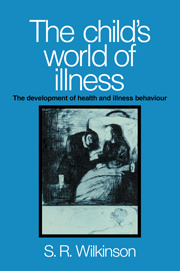Description
The Child's World of Illness
The Development of Health and Illness Behaviour
Author: Wilkinson Simon R.
Discusses the languages of illness which we use to present our discomforts to others through an exploration of the child's world of illness.
Language: English
Subject for The Child's World of Illness:
Approximative price 73.59 €
Subject to availability at the publisher.
Add to cart
Publication date: 11-2006
300 p. · 15.2x22.8 cm · Paperback
300 p. · 15.2x22.8 cm · Paperback
Description
/li>Contents
/li>
How do I decide I am ill; how do I decide that my children are ill? How do I learn effective ways of conveying to others that I am ill? This book discusses the languages of illness which we use to present our discomforts to others through an exploration of the child's world of illness. It looks at how illness concepts are introduced to children, how the causes of illness and 'germ' rationales are incorporated into the socialisation of children, and how a particular morality about health and illness is expressed. Besides the analysis of the social context within which the children's views are developing, the book presents the children's own views from three years old up to thirteen. How we talk about illness can have as important consequences as the methods we use to cure it. This book persuades the reader to look more closely at the language of illness, allowing a reappraisal to medical practice, school health programmes and class teaching, health education and even the differences in health between the social classes. In this way it forges a link between physical medicine and psychotherapy, providing the developmental perspective of illness behaviour which has long been lacking.
Acknowledgements; Glossary; 1. Presenting a problem; 2. The form of dialogue; 3. What has gone before: some background information; 4. The primary structure to the child's world of illness; 5. Germs and bugs: causal agents; 6. Dirt and fresh air: the exogenous system; 7. My castle and the good germs: the endogenous system and its boundary; 8. 'Pretend illness': an analysis of how communication patterns can foster particular forms of complaints; 9. The consultation: a form of dialogue; 10. Health education and health promotion; Appendices; References; Index.
© 2024 LAVOISIER S.A.S.




